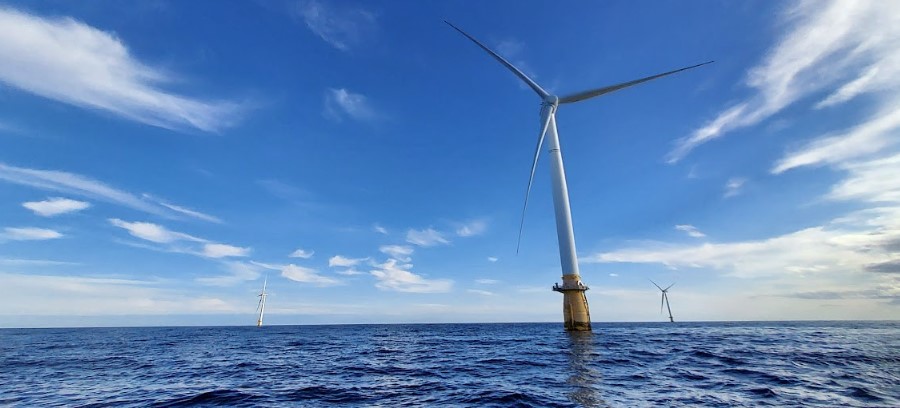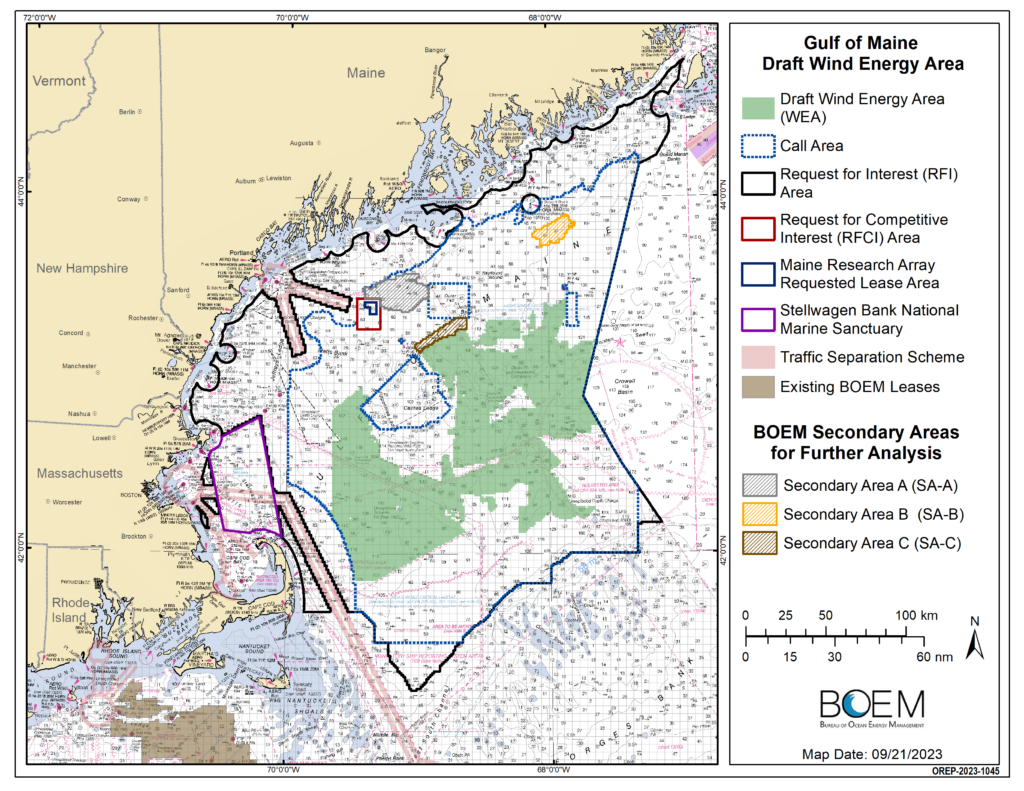
UPDATE Nov. 22, 2023: Maine Audubon joined Mass Audubon and the American Bird Conservancy in submitting comments on the Bureau of Ocean Energy Management’s draft Wind Energy Area (WEA) for the Gulf of Maine. The authors asked for a number of changes to the draft WEA in order to protect birds and other wildlife, including the removal of Secondary Areas A and B; the introduction of phased leasing; and the employment of bidding credits and certain lease stipulations, among other changes. Read our full comments here.
ORIGINAL POST: The effort to produce local wind energy took an important step forward this week when the federal Bureau of Ocean Energy Management, or BOEM, released their draft Wind Energy Area for the Gulf of Maine. Maine Audubon and our many coalition partners were pleased to see that the draft plan avoids areas of major conflict for wildlife and for the lobster fishing industry.
The draft Wind Energy Area is an area that appears most suitable for floating offshore wind energy leasing and potential development. The Bureau of Ocean Energy Management developed the map after extensive input from the fishing industry, environmental groups, and wildlife advocates including Maine Audubon.
BOEM has proposed an area it believes is suitable for floating offshore wind (in green, below), between 23 and 120 miles off the coast of Maine, New Hampshire, and Massachusetts. The Wind Energy Area has the capacity to produce more than 40 GW of energy—enough to power millions of homes—but also avoids many areas of potential conflict, including nearly all areas utilized by Maine’s critical lobstering industry.
It also excludes several important wildlife areas of special concern for Maine Audubon. The draft Wind Energy Area avoids important areas for Northern Right Whales, including the Great South Channel Restricted Area and the Cashes Ledge Extension Area (see page 77 here). BOEM also avoided most of the areas identified as of high importance to seabirds, including most Diving Birds Core Use Area and most areas assessed as High for Seabird Risk and Vulnerability (see page 78 here). The distance from the Maine coast means that the draft Wind Energy Area largely avoids conflicts with coastal birds and seabird nesting islands, thanks in large part to input from Maine Audubon biologists.
But there is more work to do. BOEM has instituted a 30-day comment period to respond to the draft Wind Energy Area, and Maine Audubon looks forward to the opportunity to take a closer look at the proposal and advocate for additional wildlife protections.
Press Release
Federal Agency Removes Nearly All of Key Fishing Ground from Wind Energy Development in Gulf of Maine
October 19, 2023 (Augusta, ME) — Fishing groups, labor unions, and environmental organizations who came together to push a compromise bill that will advance responsible offshore wind in the Gulf of Maine scored a key victory when the federal government excluded nearly all of a key fishing ground called Lobster Management Area 1 from offshore wind development today.
The announcement of the draft Gulf of Maine Wind Energy Area by the Bureau of Ocean Energy Management (BOEM) comes after the Maine Legislature passed a state law earlier this year that would develop three gigawatts of offshore wind by 2040 with strong labor standards and robust protections for wildlife.
The Maine Lobstering Union, Local 207 (MLU) worked with organized labor and environmental groups to include consensus language in the new law that provides incentives for developing wind outside of Lobster Management Area 1, the fishing grounds for nearly the entire Maine-based lobster fishery.
“This is how the process is supposed to work. The federal government listened to the concerns of our fishing communities, and now they are sending a strong signal that an offshore wind industry that fundamentally harms the hardworking Mainers making their living on the water is neither in line with Maine’s values nor welcome in the Gulf of Maine,” said Virginia Olsen, Executive Director, Maine Lobstering Union, Local 207.
Even when this key fishing area is excluded, the draft wind energy area could support the development of 40 gigawatts of offshore wind, critical to moving the New England region away from expensive and unpredictable fossil fuel power generation.
“Maine is showing that when diverse voices come to the table, we can work together to advance a new clean energy industry for Maine that bolsters our economy and creates the large amounts of offshore wind we need to power the future,” said Jack Shapiro, Climate and Clean Energy Director at the Natural Resources Council of Maine. “This is a positive step forward in a process that can meet the needs of everyone who is committed to protecting the shared resources of the Gulf of Maine.”
“This decision shows respect for the critical role that our heritage fishing industries have played and continue to play in our state’s economy and identity,” said Kelt Wilska, Energy Justice Manager at Maine Conservation Voters. “Offshore wind is the single biggest lever we can pull to address the climate crisis, meet our energy needs, and grow the economy at the same time.”
“Excluding Lobster Management Area 1 from the draft call areas is a huge step toward showing that we don’t have to choose between sustaining our iconic fishing industries and creating a long-term source of clean energy and good-paying union jobs,” said Francis Eanes, Executive Director of the Maine Labor Climate Council. “The Maine Lobstering Union and the fishing industry deserve a lot of credit for their willingness to work together with us on this issue. That’s solidarity in action and furthers our commitment to collaboratively protecting the Gulf of Maine and the thousands of livelihoods that depend on it.”
“Today’s announcement shows that this administration in Washington understands and respects the power of solidarity,” said Jason J. Shedlock, President of the Maine State Building & Construction Trades Council and officer at Local 327 of the Laborers’ Union. “We’ll continue to use our unified voice to thoughtfully inform and drive the efforts to insist offshore wind in the state of Maine is a high road industry, right from the start. We welcome decision makers at all levels of government to join us in getting to yes based on this unwavering goal.”
“We applaud BOEM for hearing the voices of Maine’s broad offshore wind coalition and from the fishing industry by protecting LMA1 in the draft wind energy area released today,” said Amy Eshoo, Director of Maine Climate Action Now.
“A transition to clean energy must take the concerns of impacted communities first and foremost. We can meet the moment with justice as our compass, and the passage of LD 1895 and this Wind Energy Area announcement are proof that we are on our way to achieving that goal,” said Elise Hartell, interim co-director for Maine Youth Climate Justice.
“We’re pleased that the draft Wind Energy Area avoids North Atlantic Right Whale Restricted Areas and Maine’s seabird nesting islands,” said Sarah Haggerty, Conservation Biologist / GIS Manager with Maine Audubon. “There will be much more to do to ensure that Gulf of Maine wildlife is protected, but siting turbines away from the most heavily used areas is an excellent first step.”
BOEM is undergoing a multi-step process of selecting specific areas in the Gulf of Maine where offshore wind could be developed responsibly. The announcement of the draft wind energy area represents a significant step forward for the potential of a new offshore wind industry in Maine, signaling that community and fishing interests can be incorporated as part of a thoughtful planning process.
In June 2023, Maine’s entire Congressional delegation joined with Governor Janet Mills in writing a letter to BOEM requesting wind energy be excluded from LMA1 because of its importance to fishing families.

